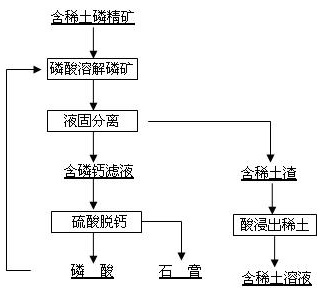Method for separating tombarthite from phosphorus ore
A technology of rare earth and phosphate rock, applied in the direction of improving process efficiency, etc., can solve problems such as economic difficulties and complex recovery process of rare earth, and achieve the effect of simple process, high rare earth grade and low slag rate
- Summary
- Abstract
- Description
- Claims
- Application Information
AI Technical Summary
Problems solved by technology
Method used
Image
Examples
Embodiment 1
[0026] Take 100g containing rare earth 0.14 wt % rare earth phosphorus concentrate and 1000 mL Contains P 2 o 5 20 wt % dilute phosphoric acid solution was mixed according to the solid-to-liquid ratio of 1:10, stirred and reacted at 15°C for 1 hour, filtered to obtain the filtrate and leached residue, weighed and analyzed the leached residue after drying, the slag rate was 22%, and the rare earth content in the slag was 0.59% 93% of the rare earths are enriched in the slag, and the enrichment factor is 4.2 times. The rare earths in the slag are leached with sulfuric acid to obtain a sulfuric acid rare earth solution. Rare earths are recovered.
Embodiment 2
[0028] Take 100g containing rare earth 0.14 wt % rare earth phosphorus concentrate and 1000 mL Contains P 2 o 5 20 wt % dilute phosphoric acid solution was mixed at a solid-to-liquid ratio of 1:10, stirred and reacted at 45°C for 1 hour, filtered to obtain the filtrate and leached residue, weighed and analyzed the leached residue after drying, the slag rate was 21%, and the rare earth content in the slag was 0.57% , 85% of rare earths are enriched in the slag, and the enrichment factor is 4.1 times. The rare earths in the slag are leached with sulfuric acid to obtain a sulfuric acid rare earth solution. One or more methods in extraction, ion exchange adsorption, precipitation, and crystallization Rare earths are recovered.
Embodiment 3
[0030] Take 100g containing rare earth 0.14 wt % rare earth phosphorus concentrate and 1000 mL Contains P 2 o 5 20 wt % dilute phosphoric acid solution was mixed at a solid-to-liquid ratio of 1:10, stirred and reacted at 16°C for 4 hours, filtered to obtain the filtrate and leached residue, weighed and analyzed after the leached residue was dried, the slag rate was 18%, and the rare earth content in the slag was 0.73% 94% of the rare earths are enriched in the slag, and the enrichment factor is 5.2 times. The rare earths in the slag are leached with sulfuric acid to obtain a sulfuric acid rare earth solution. Rare earths are recovered.
PUM
 Login to View More
Login to View More Abstract
Description
Claims
Application Information
 Login to View More
Login to View More - R&D
- Intellectual Property
- Life Sciences
- Materials
- Tech Scout
- Unparalleled Data Quality
- Higher Quality Content
- 60% Fewer Hallucinations
Browse by: Latest US Patents, China's latest patents, Technical Efficacy Thesaurus, Application Domain, Technology Topic, Popular Technical Reports.
© 2025 PatSnap. All rights reserved.Legal|Privacy policy|Modern Slavery Act Transparency Statement|Sitemap|About US| Contact US: help@patsnap.com


